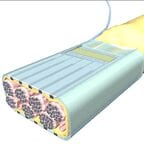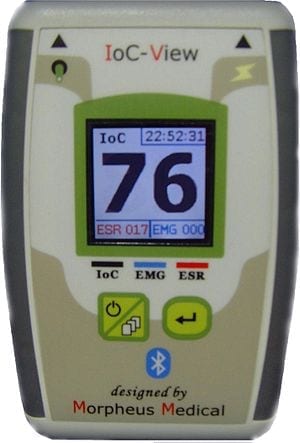
Advances enable advanced prosthetic control and direct sensory feedback
Since 2000, more than 2,000 servicemembers have suffered amputated limbs. DARPA’s breakthrough research with advanced prosthetic limbs controlled by brain interfaces is well documented, but such research is currently limited to quadriplegics; practical applications of brain interfaces for amputees are still in the future. In contrast, nerve and muscle interfaces allow amputees to control advanced prosthetics in the near term. Recent demonstrations may give Wounded Warriors hope that they can soon take advantage of these breakthroughs.
DARPA’s Reliable Neural-Interface Technology (RE-NET) program researched the long-term viability of brain interfaces and continues research to develop high-performance, reliable peripheral interfaces. These new peripheral interfaces use signals from nerves or muscles to both control prosthetics and to provide direct sensory feedback. Ongoing clinical trials present compelling examples of both interface types.
“Although the current generation of brain, or cortical, interfaces have been used to control many degrees of freedom in an advanced prosthesis, researchers are still working on improving their long-term viability and performance,” said Jack Judy, DARPA program manager. “The novel peripheral interfaces developed under RE-NET are approaching the level of control demonstrated by cortical interfaces and have better biotic and abiotic performance and reliability. Because implanting them is a lower risk and less invasive procedure, peripheral interfaces offer greater potential than penetrating cortical electrodes for near-term treatment of amputees. RE-NET program advances are already being made available to injured warfighters in clinical settings.”
A team of researchers at the Rehabilitation Institute of Chicago (RIC) demonstrated a type of peripheral interface called targeted muscle re-innervation (TMR). By rewiring nerves from amputated limbs, new interfaces allow for prosthetic control with existing muscles. Former Army Staff Sgt. Glen Lehman, injured in Iraq, recently demonstrated improved TMR technology. In the following video, Lehman demonstrates simultaneous joint control of a prosthetic arm made possible by support from the RE-NET program.
Researchers at Case Western Reserve University used a flat interface nerve electrode (FINE) to demonstrate direct sensory feedback. By interfacing with residual nerves in the patient’s partial limb, some sense of touch by the fingers is restored. Other existing prosthetic limb control systems rely solely on visual feedback. Unlike visual feedback, direct sensory feedback allows patients to move a hand without keeping their eyes on it—enabling simple tasks, like rummaging through a bag for small items, not possible with today’s prosthetics. The Case Western Reserve University video shows how direct sensory feedback makes some tasks easier. The FINE is one of many different types of nerve interfaces developed under the RE-NET program.
The Latest Bing News on:
Nerve and Muscle Interfaces
- Robotic nerve 'cuffs' could help treat a range of neurological conditionson April 26, 2024 at 2:00 am
Researchers have developed tiny, flexible devices that can wrap around individual nerve fibers without damaging them.
- Blue Arbor Technologies gets US FDA breakthrough device designation and TAP enrollment for its RESTORE systemon April 25, 2024 at 10:30 pm
Grass Lake, Michigan Friday, April 26, 2024, 11:00 Hrs [IST] ...
- Blue Arbor wins FDA breakthrough nod for neuromuscular interfaceon April 24, 2024 at 7:25 am
Blue Arbor Technologies announced today that it received FDA breakthrough device designation for its Restore neuromuscular interface system.
- Blue Arbor Technologies Receives FDA Breakthrough Device Designation and TAP Enrollment for the RESTORE™ Neuromuscular Interface Systemon April 24, 2024 at 6:06 am
FDA grants Breakthrough Device Designation to Blue Arbor RESTORE System designed to enable naturalistic function for those with upper limb prosthetics ...
- Harmony within: A holistic guide to better mental and physical wellness in 2024on April 4, 2024 at 5:00 pm
For anyone struggling to manage arthritis symptoms or muscle, joint, and nerve complaints ... Rocksmith+ guitar tuner offers a user-friendly interface that makes tuning your instrument a breeze ...
- Common Foot Pain Issues and How to Deal With Themon March 29, 2024 at 10:11 am
It alludes to aggravation of the Achilles ligament, the enormous ligament that interfaces the lower leg muscles tissues to ... of the tissue around the nerves prompting the toes, maximum generally ...
- ‘Bionic woman’ is first to have robotic limb merged with bone — and controlled with her mindon October 11, 2023 at 10:29 am
A multidisciplinary group of engineers and surgeons from Sweden, Australia and Italy wanted to develop an interface that would ... surgery that rearranged the nerves and muscles in the residual ...
- NIM Nerve Monitoring Systems from Medtronicon August 2, 2020 at 3:46 am
the NIM-Response® 3.0 and NIM-Neuro® 3.0 offer advanced nerve monitoring technology with an easy-to-use interface. NIM® systems monitor EMG activity from multiple muscles. If there is a change ...
- Mind over matter to transform liveson February 12, 2020 at 10:18 am
When China launched its Tiangong-2 space lab in 2016, one of its many aims was to test the adaptability of brain-computer interface ... BCI bypasses nerves and muscle tissues to directly connect ...
- Move A Robotic Hand With Your Nerve Impulseson December 31, 2016 at 5:31 am
The interface itself had to solve the problem of picking up the extremely weak nerve impulses while simultaneously ... regions corresponding to individual muscles. Finally, the answer that ...
The Latest Google Headlines on:
Nerve and Muscle Interfaces
[google_news title=”” keyword=”Nerve and Muscle Interfaces” num_posts=”10″ blurb_length=”0″ show_thumb=”left”]
The Latest Bing News on:
Prosthetic limb control
- Soft robotic nerve cuffs could revolutionize treatment of neurological conditionson April 26, 2024 at 5:49 pm
Researchers have developed tiny, flexible devices that can wrap around individual nerve fibres without damaging them.
- Scientists Make Breakthrough in Chronic Pain Treatmenton April 26, 2024 at 7:53 am
Scientists have developed tiny robotic nerve "cuffs" to diagnose and treat neurological disorders. The flexible devices offer a safer, minimally invasive alternative to today's diagnostics and could ...
- Blue Arbor Technologies gets US FDA breakthrough device designation and TAP enrollment for its RESTORE systemon April 25, 2024 at 10:30 pm
Grass Lake, Michigan Friday, April 26, 2024, 11:00 Hrs [IST] ...
- Local man recovering from hand amputation following hiking accidenton April 24, 2024 at 7:57 pm
A local man is on the road to recovery after losing his hand in a hiking accident.On March 16, Lemos was leading a hiking group in the Jacumba desert with the accident happened.
- Blue Arbor wins FDA breakthrough nod for neuromuscular interfaceon April 24, 2024 at 7:25 am
Blue Arbor Technologies announced today that it received FDA breakthrough device designation for its Restore neuromuscular interface system.
- Stellar Blade review: "A good action-RPG that I enjoyed a lot despite several issues"on April 24, 2024 at 7:00 am
Takes you closer to the games, movies and TV you love Issues delivered straight to your door or device ...
- Blue Arbor Technologies Receives FDA Breakthrough Device Designation and TAP Enrollment for the RESTORE™ Neuromuscular Interface Systemon April 24, 2024 at 6:06 am
FDA grants Breakthrough Device Designation to Blue Arbor RESTORE System designed to enable naturalistic function for those with upper limb prosthetics ...
- TopSpin 2K25 review – game, set and match to an engrossing tennis simon April 24, 2024 at 5:00 am
Whether you’re playing as a real-life pro or your own wacky avatar, this subtly calibrated title will have you perfecting your lobs and dropshots for hours ...
- Brain's Cerebellum Could Help Direct Prosthetic Limbson April 16, 2024 at 4:36 am
Key Takeaways The brain's cerebellum could help people better control robot limbs, wheelchairs and keyboards Input from the cerebellum appeared to help lab rats better control a robot water tube ...
- Boosting the brain's control of prosthetic devices by tapping the cerebellumon April 15, 2024 at 8:41 am
Neuroprosthetics, a technology that allows the brain to control external devices such as robotic limbs, is beginning to emerge as a viable option for patients disabled by amputation or neurological ...
The Latest Google Headlines on:
Prosthetic limb control
[google_news title=”” keyword=”prosthetic limb control” num_posts=”10″ blurb_length=”0″ show_thumb=”left”]











